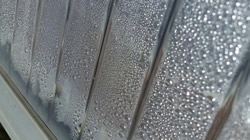Difference between Water Vapor and Steam
Key Difference: Water vapor is when water molecules are present in the air, while steam is water heated to the point that it turns into gas. In simplified science, both are referred to as the gaseous state of water. Steam is usually white or translucent in nature, while water vapor can be clear or translucent. Steam is believed to be basically water vapor at a higher temperature.
 Water vapor and steam are two things that we come across everyday even if we are not aware of it. These states of water happen everyday during the water cycle. However, many people are often confused as to what is the difference between water vapor and steam. Are they different from each other? Or just different terms that refer to the same thing? While, many suggest that water vapor and steam are the same, and even use the terms interchangeably; there is a slight difference between them.
Water vapor and steam are two things that we come across everyday even if we are not aware of it. These states of water happen everyday during the water cycle. However, many people are often confused as to what is the difference between water vapor and steam. Are they different from each other? Or just different terms that refer to the same thing? While, many suggest that water vapor and steam are the same, and even use the terms interchangeably; there is a slight difference between them.
In simplified science, both are referred to as the gaseous state of water. There is technically no difference between the two term. However, when used colloquially, there is a slight difference between the usage of the two terms. The main difference lies in temperature. Water vapor is when little water droplets, i.e. water molecules, exist in the air. These water droplets could be invisible to the eye, but they are there. Steam, on the other hand, is when water is heated to the point that it turns into gas. Hence, it can be said said that steam is the gaseous form of water.
Now, let’s try and explain this using an example. When a person leaves their clothes to air dry, the water from the clothes evaporates slowly as the temperature around the cloth changes. This is evaporation, which leads to water vapor. The water becomes absorbed in the air which leaves the clothes dry. Now, when we put a kettle of water to boil, after a moment we see the water lessening and a few wisps of white escaping the kettle. This is steam. Steam is usually white or translucent in nature, while water vapor can be clear or translucent.
 Water vapor is ever present, whether one can see it or not. Water vapor is basically air with the presence of water molecules, and as water molecules are always present in air, so it water vapor. Steam is believed to be basically water vapor at a higher temperature which also causes it to be seen. In water vapor, there is still water droplets that are present, which can be further cooled down to turn back into water. In steam, water converts purely into gas. Water vapor does not require heating or adding the element of heat, water vapor can form by evaporation or the temperature around the water. However, in order to have steam, water is required to be boiled at a certain temperature (above boiling temperature of water) to form steam.
Water vapor is ever present, whether one can see it or not. Water vapor is basically air with the presence of water molecules, and as water molecules are always present in air, so it water vapor. Steam is believed to be basically water vapor at a higher temperature which also causes it to be seen. In water vapor, there is still water droplets that are present, which can be further cooled down to turn back into water. In steam, water converts purely into gas. Water vapor does not require heating or adding the element of heat, water vapor can form by evaporation or the temperature around the water. However, in order to have steam, water is required to be boiled at a certain temperature (above boiling temperature of water) to form steam.
If you search water vapor vs. steam, it will result in confusing terms as many websites claim that there is no difference between water vapor and steam, while others claim that water vapor and steam are really different. However, they do go hand-in-hand as they are both properties of water. In order to simply, let’s think of it in this way. When the ice melts at room temperature, it forms condensation on the glass and has if you place a plate or a flat surface on top of the glass or bowl of ice, you would see there are visible water droplets on the top of that plate or surface. This is basically water vapor, which requires water droplets to be in the air. Now, if you heat up a kettle of water, the hot white air that is released out of the kettle is steam, which also has tiny water droplets but much of it escapes in the air.
Comparison between Water Vapor and Steam:
|
|
Water Vapor |
Steam |
|
Description |
Presence of water molecules |
Water in gaseous form |
|
Scientific Description |
Gaseous State of Water |
Form of Water Vapor |
|
Visibility |
Can be Visible or Invisible, commonly invisible |
Can be Visible or Invisible, but typically refers to the visible form |
|
Temperature |
Any temperature |
Above Boiling Point |
Reference: Wikipedia (Water Vapor and Steam), Simple Wikipedia (Water Vapor and Steam) Image Courtesy: tigermountaintile.com, home.howstuffworks.com









Comments
Dr Dan
Sat, 01/06/2018 - 21:19
Confused Bob
Wed, 07/20/2016 - 15:55
Water vapor is little water droplets that exist in the air.
This is simply flat-out wrong. Water vapor is completely gaseous, as well as invisible.
One Who Knows
Sun, 03/15/2015 - 00:20
Gordon
Fri, 03/09/2018 - 07:16
Professor freeman
Fri, 06/30/2017 - 02:35
thanks! a lots much, what iconfused before this intersting notes.
.
kassew alemye
Mon, 04/21/2014 - 18:52
good
tom
Thu, 01/23/2014 - 18:08
Add new comment